
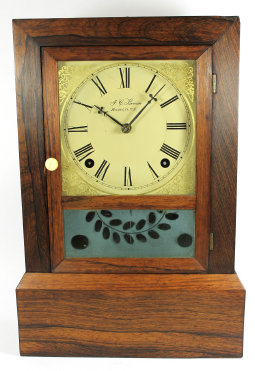
421. $150
J. C. Brown Cottage, ca. 1850. The refinished rosewood case is 14.75 inches high; the
veneer is in good shape with some lifting on the right side where it appears that heat damage to the back occurred. If there
was ever any gold stenciling on the case itself there is no sign of it now. There is a chip at the top right corner. The
upper glass has a crack running across it which is not visible except at certain angles, and there seems to be a coating over the
entire glass from the inside, perhaps to seal the crack and stabilize the glass. The typical gold stencil on this glass is nearly
complete; sometimes you see this backed in black, but not always. The lower cut and frosted glass is old (there is a large bubble
on the right side) and usually is suggested to not be original, as these clocks often had a reverse-painted scene or image of Brown,
but there are a number of examples of this clock with a frosted lower glass. The door handle is original ivory/bone. The
signed dial has been repainted, the hands correct and probably original. The eight-day time-and-strike movement is signed Forestville
Manufacturing and is running and striking as expected. There is a nice green label inside. These clocks are not uncommon but
remain popular and vary widely in price. $100-$250.
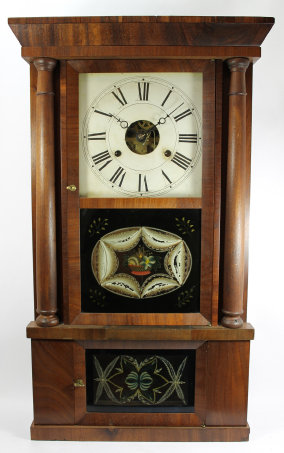
423. $195
Chauncey Jerome “Column & Cornice”, 1845-1855. A 26.5-inch case with good mahogany veneer,
a few chips along the base and the center section of the segment between the upper and lower door having been replaced. No doubt
the entire case has been refinished, and the columns originally may have been gold leaf or black, or a combination of both. The upper and lower tablets are the main attractions here – original and in outstanding condition; the dial glass is old as well. The metal dial has been touched up but looks good and there is about half of a label inside, clearly indicating a Jerome case manufactured
in New Haven with a label printed by Benham in New Haven. The 30-hour weight-driven brass movement is also signed by Jerome
and was made in Bristol, dating it to before the fire that destroyed his Bristol factory in 1845. The clock is running and striking
as required. $200-$325.
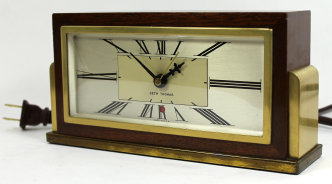
424. $35
Seth Thomas “Baxter-2E”, 1948. This is a self-starting electric clock, time only, no alarm. A “solid mahogany case is enhanced by judicious use of highly polished brass side pieces.” Indeed. The hands are correct
and include a sweep second hand, 4.25 inches high by 8.5 inches wide, shaped glass over the silver and ivory dial. Red indicator
dot when the power goes off, resets to white when you set the time. Gosh, they thought of everything! Running and keeping
time. We replaced the old cracked cord. You gotta like the sleek modern styling. $35-$75.

422. $125
F. Kroeber “Cabinet No. 51”, ca. 1888. One of many cabinet clocks marketed by Kroeber in New
York in the late 1800’s. This one can be found on page 138 of Ly’s book on Kroeber clocks. It stands 14 inches high and
has a 4-inch chapter ring on a new paper dial. The bezel is shiny brass with an old flat glass. The case is walnut with
a mahogany color and looks to be the original finish, cleaned and waxed. You can even see the gold paint in the incising on
the front. The signed 8-day movement is dirty but is running and keeping time. It strikes a Kroeber wire gong on the hour
and half-hour. No sales records that we can find; we estimate $125-$225.
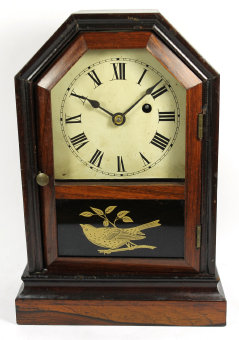
425. $100
Atkins “Octagon Top”, ca. 1875. This clock has a very nice rosewood veneer with ebonized trim
and stands just over 10 inches high. The veneer is in excellent shape with no chips or scrapes. It has two old glasses
and a repainted dial that has been “aged”. The unsigned 30-hour time-only movement is running. The label is for a retailer
out of Boston but it is almost certainly an Atkins clock.
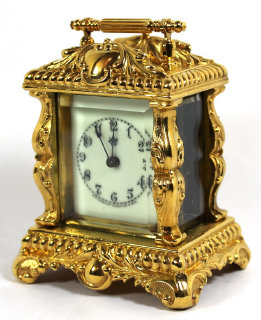
426. $225
Waterbury “Rambler” carriage clock, ca. 1906. This 5-inch carriage clock has been replated
in a rich gold finish, looking much like a factory-new clock would. There are three beveled glasses, a signed porcelain dial,
and a bell on the bottom to strike the hours and half-hour. The handle is not correct but looks fine. The clock is running,
fast, and the strike spring is broken or not attached so it doesn’t sound the hours. There is a repeater button that restrikes
the hours, useful if you keep this clock on your nightstand (and you fix the strike spring). There is a list of patent dates
on the rear door, the most recent being 1891. You rarely find these clocks in replated (or good original) condition.
